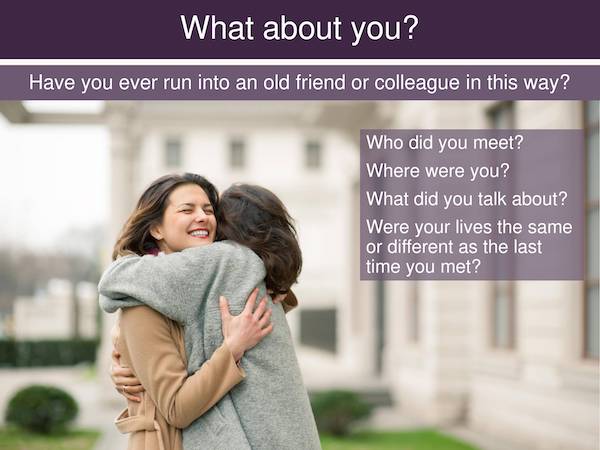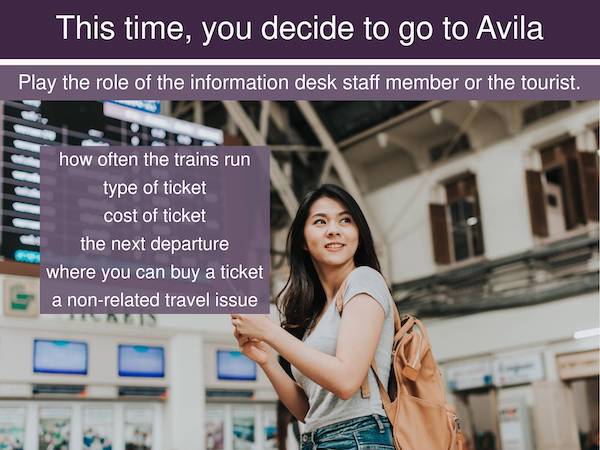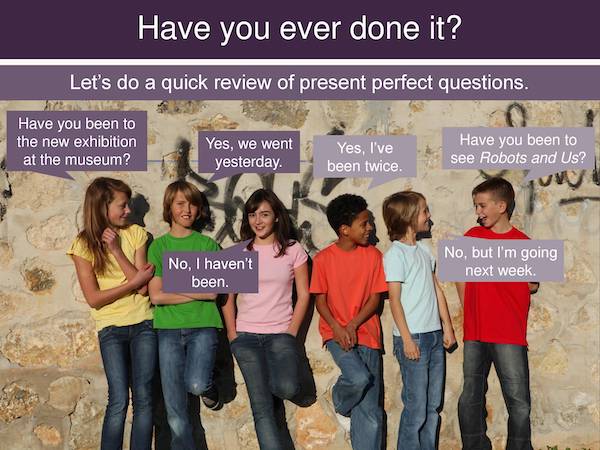{{ post.title }}
{{ post.excerpt }}
Read full storyWe’re excited to release the first of our B1 lessons in the Off2Class Step-By-Step Curriculum. These are the first 12 lessons for your Pre-Intermediate students, and just like our previously released lessons in the curriculum, Units 25, 26 and 27 contain speaking, listening, reading, and writing Yes/no question activities. Use these lessons to teach your ESL students about communication, tourism and experiences! Here’s Sandra to tell you about it:
.
.
.
Of the four language skills, students assign the greatest importance to speaking. To teach ESL students about communication, tourism and experiences, we’ll start with spoken communication. In this unit, we give students lots of speaking practice, though there is — of course — a strong mixture of reading, writing, listening and speaking tasks in the lessons.
.

.
One of the things we all do on a regular basis is to communicate with people we don’t know. Communicating in a foreign language is challenging for many students, yet at the pre-intermediate level student have enough language to start having short, natural conversations. The biggest challenge is to use correct questions forms in English, and this is what we focus on.
At early B1 level, students should be able to start forming sentences using the present simple, present continuous, past simple and present perfect. They will need help with information questions and yes/no questions. Further, students must learn to form questions differently for questions with be and questions with verbs other than be.
First, we look at questions with be, such as:
Are you hungry? or Are we going to the beach?
in which students must learn to use subject-verb inversion. Second, we look at questions with verbs other than be, such as:
Do you like working here? or Did you go to the meeting
in which students must insert do before the subject. Finally, we look at some (but not all) forms of information questions, otherwise known as Wh- questions, such as
Where are you going? and How many did you buy?
in which students must learn which question word or words are used, depending on the object of the sentence. Successful acquisition of question forms takes times and requires a lot of practice. We make sure that students end this unit with the confidence to ask plenty of questions to their colleagues and classmates
Everyone loves talking about travel experiences. In this unit, students have the opportunity to read, listen, write and talk about the little things that go wrong on vacation. We use past experiences to look at the pronunciation of -ed in regular past simple verbs. It comes together quite nicely to teach ESL students about communication, tourism and experiences.
.

.
As you’ll remember, there are three rules that students need to learn, all based on the sound of the last letter in the infinitive
First, verbs that have /t/ or /d/ as the final sound pronounce -ed as /ɪd/, such as:
He completed the exam.
We waited at the train station.
Second, verbs that have /p/, /f/, /s/, /sh/, /tch/ or /k/ as the final sound pronounce -ed as /t/, such as:
They washed the car.
We laughed at his jokes.
Finally, verbs that end of sounds other than those listed above pronounce -ed at /d/, such as:
I arrived late.
Dad prepared sandwiches.
This lesson may well be the first time that your student encounters such explicit phonetic-based rules. Teach these three rules well to ensure they don’t leave the pre-intermediate level without this knowledge
Students generally first encounter the present perfect simple toward the end of A2. The present perfect remains challenging for many students and some never master it. It’s a good idea to review and return to the present perfect again and again during a student’s ESL course. It’s a good grammar point to integrate to teach ESL students about communication, tourism and experiences.
.

.
Additionally, it’s not an easy tense to teach. Truth be told, it a tense that gets a lot of teachers stuck. The present perfect is hard to teach because it’s often very hard to provide endless concept check questions or set up situations in which the present perfect can be elicited naturally
However, where there is a present perfect, a past simple is never far behind. In this lesson, students increase their confidence to use the present perfect by comparing it with the past simple. There are few watertight rules about when to use the present perfect, but we provide the following for students:
First, expressions referring to a specific point in the past usually preclude the present perfect:
I met her yesterday, and not
I have met her yesterday.
Second, we often use the present perfect with an unfinished time which is also not expressed. The time inferred is something like ‘in my life’. For example:
I have played basketball many times.
We have traveled to France twice.
Third, a commonly used set of words almost always provokes the present perfect, such as ever, never, already, just and yet. For example:
Have you ever been to Peru? I’ve never swum in the ocean.
We know there’s a whole lot more to teach ESL students about communication, tourism and experiences than a few simple tips. However, we hope that this post presents a few things worth thinking about before you teach the grammar and language in these units.
Leave a reply